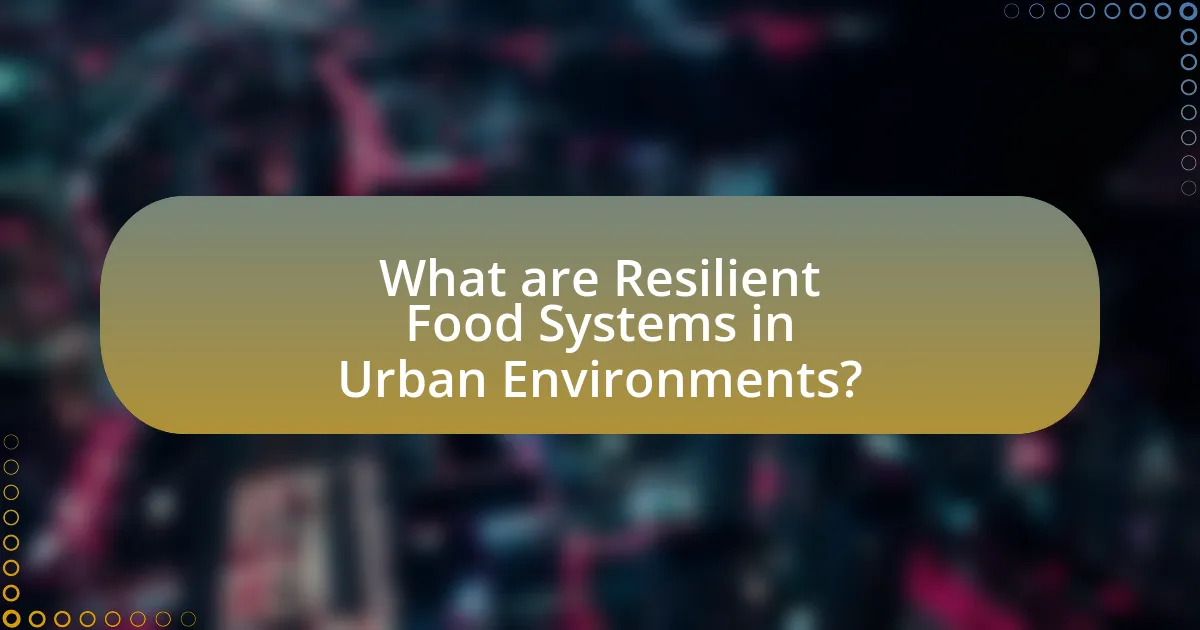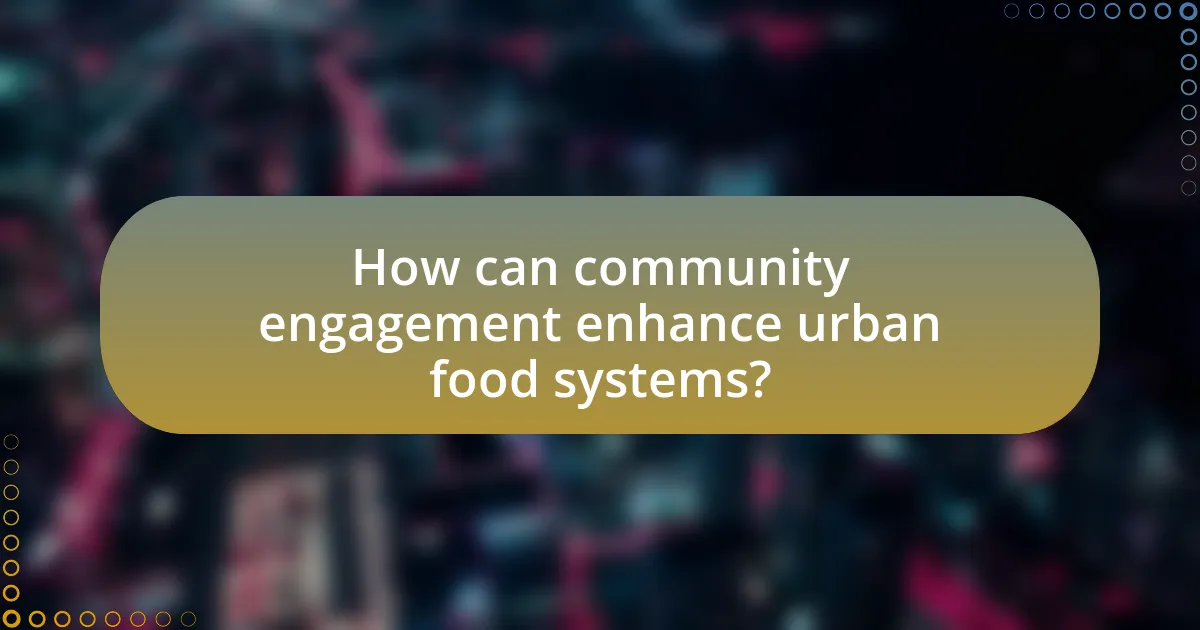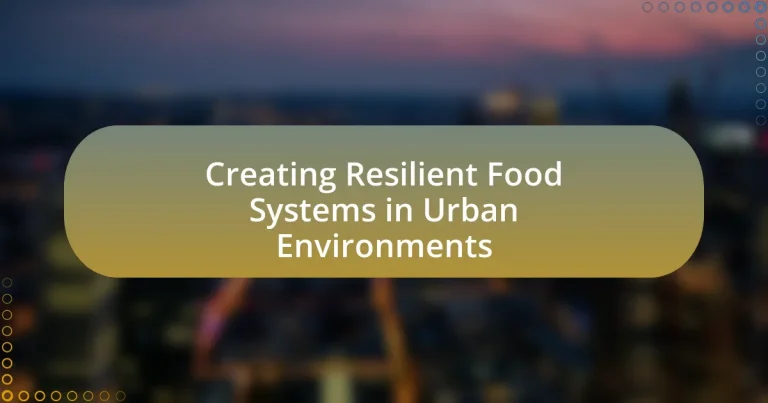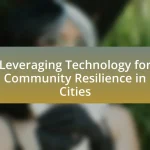Resilient food systems in urban environments are essential frameworks that ensure food security and sustainability amidst challenges such as climate change and population growth. These systems emphasize local food production, distribution, and consumption, enhancing community self-sufficiency and reducing reliance on external sources. Key characteristics include diversity, adaptability, and sustainability, which differentiate them from traditional food systems that often depend on global supply chains. The article explores the importance of resilience in urban food systems, the challenges posed by urbanization and climate change, and strategies for creating robust local food networks, including community engagement and educational initiatives. Additionally, it highlights the economic implications of resilient food systems, including job creation and cost savings associated with local food production.

What are Resilient Food Systems in Urban Environments?
Resilient food systems in urban environments are frameworks that ensure food security and sustainability despite challenges such as climate change, economic fluctuations, and population growth. These systems integrate local food production, distribution, and consumption practices that enhance community self-sufficiency and reduce dependency on external food sources. For instance, urban agriculture initiatives, such as community gardens and vertical farms, contribute to local food availability and reduce transportation emissions. Research indicates that cities with resilient food systems can better withstand disruptions, as evidenced by studies showing that urban agriculture can increase food access by up to 30% during crises.
How do resilient food systems differ from traditional food systems?
Resilient food systems differ from traditional food systems primarily in their ability to adapt to and recover from disruptions. Resilient food systems incorporate diverse agricultural practices, local sourcing, and sustainable methods, which enhance their capacity to withstand environmental changes, economic shocks, and social challenges. For instance, a study by the Food and Agriculture Organization highlights that resilient systems often utilize agroecological practices that promote biodiversity, thereby reducing dependency on external inputs and increasing food security. In contrast, traditional food systems typically rely on monoculture and global supply chains, making them more vulnerable to crises such as climate change and market fluctuations.
What key characteristics define a resilient food system?
A resilient food system is characterized by diversity, adaptability, and sustainability. Diversity ensures a variety of crops and livestock, which reduces vulnerability to pests and diseases, as evidenced by studies showing that polycultures can outperform monocultures in yield stability. Adaptability allows the system to respond effectively to changing environmental conditions and market demands, supported by examples of urban agriculture initiatives that adjust practices based on local climate and community needs. Sustainability focuses on minimizing environmental impact and promoting social equity, with research indicating that sustainable practices, such as organic farming and local sourcing, enhance long-term food security and community health.
Why is resilience important in urban food systems?
Resilience is crucial in urban food systems because it enables these systems to withstand and recover from disruptions such as climate change, economic shifts, and social challenges. Urban food systems face unique vulnerabilities due to their reliance on complex supply chains and high population densities. For instance, a study by the Food and Agriculture Organization highlights that resilient food systems can reduce food insecurity by maintaining consistent food availability during crises. Additionally, resilient urban food systems promote local food production, which can mitigate the impacts of global supply chain disruptions, as evidenced by the increase in urban agriculture initiatives during the COVID-19 pandemic.
What challenges do urban environments face in food system resilience?
Urban environments face significant challenges in food system resilience, primarily due to limited space for agriculture, reliance on external food sources, and vulnerability to climate change. The restricted land availability in cities hampers local food production, leading to increased dependence on food imports, which can be disrupted by supply chain issues. Additionally, urban areas often experience higher temperatures and extreme weather events, which can adversely affect food supply and distribution. According to the Food and Agriculture Organization, urban areas are projected to house 68% of the global population by 2050, intensifying these challenges as demand for food increases while local production capabilities remain constrained.
How do urbanization and population growth impact food systems?
Urbanization and population growth significantly strain food systems by increasing demand for food while complicating supply chains. As urban areas expand, the concentration of people leads to higher food consumption, necessitating efficient distribution networks. According to the Food and Agriculture Organization, urban populations are expected to reach 68% of the global population by 2050, intensifying the need for sustainable food production methods. Additionally, urbanization often results in the loss of agricultural land, which further challenges food availability. This dynamic creates a pressing need for innovative solutions, such as urban agriculture and improved logistics, to ensure food security in densely populated areas.
What role do climate change and environmental factors play?
Climate change and environmental factors significantly impact food systems in urban environments by altering agricultural productivity and food security. Rising temperatures, changing precipitation patterns, and increased frequency of extreme weather events disrupt crop yields and affect the availability of fresh produce. For instance, a study by the Intergovernmental Panel on Climate Change (IPCC) indicates that climate change could reduce global agricultural productivity by up to 25% by 2050, particularly in vulnerable regions. Additionally, urban areas face challenges such as air pollution and soil degradation, which further compromise food quality and safety. These environmental factors necessitate the development of resilient food systems that can adapt to changing conditions and ensure sustainable food access for urban populations.
What strategies can be employed to create resilient food systems?
To create resilient food systems, strategies such as diversifying food sources, implementing sustainable agricultural practices, and enhancing local food networks can be employed. Diversifying food sources reduces dependency on single crops, mitigating risks associated with climate change and market fluctuations. Sustainable agricultural practices, including organic farming and permaculture, improve soil health and increase biodiversity, which are crucial for long-term productivity. Enhancing local food networks fosters community engagement and shortens supply chains, making food systems more responsive to local needs. According to the Food and Agriculture Organization, diverse and sustainable practices can significantly improve food security and resilience in urban environments.
How can urban agriculture contribute to food system resilience?
Urban agriculture enhances food system resilience by increasing local food production, thereby reducing dependency on external supply chains. This localized approach mitigates risks associated with transportation disruptions and global market fluctuations. For instance, during the COVID-19 pandemic, urban farms demonstrated their ability to provide fresh produce to communities, highlighting their role in maintaining food access when traditional supply chains were strained. Additionally, urban agriculture promotes biodiversity and sustainable practices, which contribute to ecosystem health and adaptability in the face of climate change. Studies indicate that cities with robust urban agriculture initiatives experience improved food security and community engagement, further solidifying their resilience.
What are the benefits of local food networks in urban settings?
Local food networks in urban settings enhance food security, promote economic development, and foster community engagement. These networks provide residents with access to fresh, locally sourced produce, which can reduce reliance on imported food and lower transportation emissions. According to a study by the USDA, local food systems can increase the resilience of urban areas by creating jobs and supporting local farmers, thereby stimulating the local economy. Additionally, local food networks encourage social interactions and community building, as they often involve farmers’ markets and community-supported agriculture programs that connect consumers directly with producers. This engagement can lead to increased awareness of food issues and healthier eating habits among urban populations.

How can community engagement enhance urban food systems?
Community engagement enhances urban food systems by fostering collaboration among local stakeholders, which leads to improved access to fresh produce and sustainable practices. Engaged communities can identify specific food needs, advocate for local food policies, and support urban agriculture initiatives, resulting in increased food security. For instance, cities with active community gardens often report higher levels of food access and nutritional awareness, as seen in studies conducted by the American Community Gardening Association, which highlight the positive impact of community involvement on local food systems.
What role do local communities play in building resilient food systems?
Local communities play a crucial role in building resilient food systems by fostering local food production, enhancing food security, and promoting sustainable practices. These communities often engage in urban agriculture, which not only increases access to fresh produce but also strengthens local economies. For instance, community gardens and farmers’ markets provide direct access to food, reducing reliance on external supply chains. Research indicates that urban agriculture can increase food sovereignty, allowing communities to make decisions about their food sources, as highlighted in the report “Urban Agriculture: A Global Perspective” by the Food and Agriculture Organization. Additionally, local communities often collaborate to share resources and knowledge, which enhances adaptive capacity in the face of climate change and economic challenges.
How can community gardens foster resilience in urban areas?
Community gardens can foster resilience in urban areas by enhancing food security, promoting social cohesion, and improving environmental sustainability. These gardens provide local access to fresh produce, which reduces reliance on external food sources and mitigates the impact of supply chain disruptions. Research indicates that urban agriculture, including community gardens, can increase food production by up to 15% in cities, thereby directly addressing food scarcity issues. Additionally, community gardens serve as social hubs, bringing together diverse populations, fostering relationships, and building community networks that are crucial during crises. Studies show that neighborhoods with strong social ties are more resilient to disasters, as they can mobilize resources and support more effectively. Furthermore, these gardens contribute to urban biodiversity and help manage stormwater, which enhances the ecological health of urban environments. By integrating food production with community engagement and environmental stewardship, community gardens play a vital role in creating resilient urban food systems.
What are effective ways to involve residents in food system planning?
Effective ways to involve residents in food system planning include conducting community workshops, establishing local food councils, and utilizing participatory mapping techniques. Community workshops facilitate direct dialogue between residents and planners, allowing for the sharing of local knowledge and preferences. Local food councils empower residents to have a formal role in decision-making processes, ensuring that their voices are heard in policy development. Participatory mapping techniques enable residents to visually express their needs and ideas regarding food access and resources, fostering a collaborative approach to planning. These methods have been shown to enhance community engagement and lead to more sustainable food systems, as evidenced by case studies in urban areas where resident involvement has led to improved food access and local food initiatives.
How does education influence urban food system resilience?
Education enhances urban food system resilience by equipping individuals and communities with knowledge and skills necessary for sustainable practices. For instance, educational programs focused on urban agriculture, nutrition, and food security empower residents to engage in local food production, thereby reducing dependency on external food sources. Research indicates that cities with higher levels of education in food systems demonstrate improved adaptive capacity to food supply shocks, as educated individuals are more likely to implement innovative solutions and community-based initiatives. Furthermore, studies show that educational outreach can lead to increased awareness of food waste reduction strategies, which further strengthens the resilience of urban food systems by optimizing resource use and minimizing environmental impact.
What educational programs can promote sustainable practices?
Educational programs that can promote sustainable practices include community gardening initiatives, urban agriculture courses, and sustainability-focused workshops. Community gardening initiatives teach participants about local food production, biodiversity, and ecological stewardship, fostering a connection to sustainable practices. Urban agriculture courses provide practical skills in growing food in urban settings, emphasizing resource efficiency and waste reduction. Workshops on sustainability cover topics such as composting, permaculture, and renewable energy, equipping individuals with knowledge to implement sustainable practices in their daily lives. These programs have been shown to increase awareness and engagement in sustainable practices, contributing to the development of resilient food systems in urban environments.
How can awareness campaigns improve community participation?
Awareness campaigns can improve community participation by effectively educating residents about the importance of local food systems and encouraging their involvement in sustainable practices. These campaigns raise awareness through targeted messaging, workshops, and community events that highlight the benefits of participating in local food initiatives, such as community gardens and farmers’ markets. Research indicates that communities engaged in awareness campaigns experience increased participation rates; for instance, a study published in the Journal of Community Development found that neighborhoods with active awareness initiatives saw a 30% rise in volunteer involvement in local food projects. This demonstrates that informed communities are more likely to engage in activities that strengthen their food systems and overall resilience.

What are the economic implications of resilient food systems in urban areas?
Resilient food systems in urban areas enhance local economies by increasing food security, reducing dependency on external supply chains, and creating job opportunities. These systems promote local agriculture, which can lead to a 30% increase in local food production, as evidenced by studies showing that urban farming initiatives can significantly boost local economies. Additionally, resilient food systems can lower food prices by reducing transportation costs and spoilage, ultimately benefiting consumers. Furthermore, they contribute to economic diversification by fostering entrepreneurship in food-related businesses, which can generate up to 1.5 million jobs in urban settings, according to the Food and Agriculture Organization.
How do resilient food systems contribute to local economies?
Resilient food systems contribute to local economies by enhancing food security, creating jobs, and promoting local agricultural practices. These systems ensure a stable supply of food, which reduces dependency on external sources and mitigates the impact of economic shocks. For instance, a study by the Food and Agriculture Organization indicates that local food systems can generate up to 13 jobs for every $1 million spent, compared to only 3 jobs in conventional food systems. Additionally, resilient food systems encourage the development of local markets, which keeps financial resources within the community and stimulates economic growth. This localized approach not only supports farmers but also fosters community engagement and strengthens social ties, further contributing to economic resilience.
What are the potential cost savings associated with local food production?
Local food production can lead to significant cost savings by reducing transportation expenses, minimizing spoilage, and lowering storage costs. When food is produced closer to consumers, transportation costs decrease due to shorter distances, which can account for up to 10-20% of food prices. Additionally, local food systems often experience less spoilage because products are harvested at peak ripeness and sold quickly, which can reduce waste by 30-50%. Furthermore, local producers may have lower overhead costs related to storage and distribution, leading to overall savings for consumers. These factors collectively contribute to a more efficient food system that can save money for both producers and consumers.
How can job creation in urban agriculture impact communities?
Job creation in urban agriculture can significantly enhance community resilience by providing employment opportunities, improving food security, and fostering social cohesion. Urban agriculture initiatives often create jobs in farming, distribution, and related services, which can reduce unemployment rates in urban areas. For instance, a study by the American Community Gardening Association found that community gardens can create up to 20 jobs per garden, contributing to local economies. Additionally, these jobs often focus on sustainable practices, which can lead to healthier food options and reduced reliance on external food sources, thereby improving food security. Furthermore, urban agriculture promotes community engagement and collaboration, as residents work together towards common goals, strengthening social ties and community identity.
What funding opportunities exist for developing resilient food systems?
Funding opportunities for developing resilient food systems include government grants, private sector investments, and international aid programs. For instance, the U.S. Department of Agriculture offers various grants such as the Community Food Projects Competitive Grant Program, which supports innovative food system projects. Additionally, organizations like the Global Environment Facility provide funding for sustainable agricultural practices that enhance food security. Research indicates that investments in urban agriculture can yield significant economic returns, with studies showing that every dollar invested can generate up to $6 in economic benefits.
How can public-private partnerships support urban food initiatives?
Public-private partnerships can support urban food initiatives by leveraging resources, expertise, and networks from both sectors to enhance food security and sustainability. These collaborations can facilitate investment in urban agriculture, improve supply chain efficiencies, and promote innovative food distribution models. For instance, a study by the Food and Agriculture Organization highlights that partnerships between local governments and private companies can lead to the establishment of community gardens and urban farms, which increase access to fresh produce in food deserts. Additionally, such partnerships can provide technical assistance and funding for local food businesses, thereby strengthening the local economy and creating jobs.
What grants and resources are available for urban agriculture projects?
Numerous grants and resources are available for urban agriculture projects, including the USDA’s Community Food Projects Competitive Grant Program, which provides funding to support food access and community development initiatives. Additionally, the Sustainable Agriculture Research and Education (SARE) program offers grants for research and education projects that promote sustainable practices in agriculture. Local government initiatives and nonprofit organizations also frequently provide funding opportunities, such as the Green Infrastructure Grant Program, which supports urban farming and green space development. These resources aim to enhance food security, promote sustainable practices, and foster community engagement in urban settings.
What best practices can be implemented for resilient urban food systems?
Best practices for resilient urban food systems include promoting local food production, enhancing food distribution networks, and implementing sustainable agricultural practices. Local food production, such as community gardens and urban farms, increases food security and reduces reliance on external supply chains. Enhancing food distribution networks through technology and partnerships can improve access to fresh produce, especially in underserved areas. Sustainable agricultural practices, including permaculture and organic farming, contribute to environmental health and biodiversity, ensuring long-term viability of food systems. These practices are supported by studies indicating that urban agriculture can reduce food deserts and improve community resilience against economic and environmental shocks.
How can cities effectively integrate food systems into urban planning?
Cities can effectively integrate food systems into urban planning by incorporating urban agriculture, food access policies, and sustainable transportation networks. Urban agriculture initiatives, such as community gardens and rooftop farms, enhance local food production and reduce food deserts, which are areas with limited access to affordable and nutritious food. For instance, cities like Detroit have revitalized vacant lots into productive gardens, improving food security for residents. Additionally, implementing food access policies ensures that all communities have equitable access to healthy food options, as seen in cities like San Francisco, which has established programs to support local farmers’ markets in underserved neighborhoods. Furthermore, developing sustainable transportation networks facilitates the distribution of food from local producers to consumers, reducing carbon footprints and enhancing food freshness. Research from the Food and Agriculture Organization indicates that cities with integrated food systems can improve public health, economic resilience, and environmental sustainability.
What are the key indicators of success for resilient food systems?
Key indicators of success for resilient food systems include food security, diversity of food sources, sustainability of agricultural practices, and community engagement. Food security ensures that all individuals have access to sufficient, safe, and nutritious food, which is essential for health and well-being. A diverse range of food sources enhances resilience by reducing dependency on single crops and mitigating risks associated with climate change and market fluctuations. Sustainable agricultural practices, such as organic farming and agroecology, contribute to long-term productivity while preserving environmental health. Community engagement fosters local participation in food systems, empowering individuals and enhancing social cohesion. These indicators are supported by studies showing that diverse and sustainable food systems are more capable of withstanding shocks, such as economic downturns or natural disasters, thereby ensuring consistent food availability and access.


